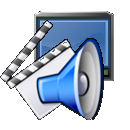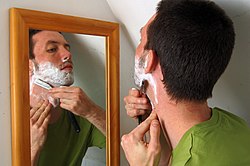教育/生活技能中的辅助技术

《残疾人教育改进法案》(IDEA 2004)将辅助技术定义为“任何商品、设备或产品系统,无论是商业化购买、改装还是定制,其用于提高、维持或改善残疾儿童的功能能力”(IDEA 2004, 2004)。[1] “功能能力”一词可能意味着在教育课堂中成功执行的全部技能和能力范围。然而,本华夏公益教科书将涉及残疾儿童在毕业后成功过渡到独立生活所需的功能技能或生活技能,通过“将技能转移到新的环境中”(Rocchio, 1995, p. 1)。[2] 功能技能建立在现实生活中的学习和生活中。对许多有严重残疾的人及其家人来说,他们希望为个人确保最完整、最令人满意的生活质量,让他们为他们所生活的世界做出贡献,同时照顾好自己(Langone, Clees, Rieber, Matzko, 2003)。[3]

在考虑以下问题后,技能或活动被定义为功能性
- 该活动执行的频率如何?
- 该活动会提高学生的独立性吗?
- 该活动是在各种自然环境中进行的吗?
- 这项职业任务是有人会付钱让学生做的事吗?
- 该活动的执行会反映学生的能力吗?
- 该技能可能自然得到强化吗?
- 如果孩子做不到,是否需要有人替他/她做?
(Brown, Falvey, Vincent, Kaye, Johnson, Ferrara-Parish, & Gruenewald, 1980)[4]
与以往相比,残疾人更有机会独立生活、获得和维持工作,并在当今社会享受许多社会福利(Scherer, 2002)。[5] 辅助和适应性技术帮助实现了这种愿景和现实。例如,市场上有一些软件技术可以帮助有严重残疾的学生通过重复练习、简单的界面设计和适当的生活技能内容来实现独立。本华夏公益教科书将建议哪些类型的特定内容辅助技术软件可用于教生活技能教室的学生功能技能。对于本华夏公益教科书,生活技能学生将被定义为有严重残疾(通常是认知方面)的初中和高中儿童,他们的认知需求超出正常学术内容,涉及有助于他们在社会中茁壮成长的主题和概念。正如 IDEA 2004 所述,这是我们学区为具有特殊生活技能需求的学生提供的法律义务(IDEA 2004, 2004)。[6] 为了确保包容的教育环境和所有学生的学习机会,管理人员、教师、工作人员、家长和学生应该了解软件中有哪些内容可以帮助生活技能学生学习。功能技能的发展推动残疾学生朝着成功参与社会迈进。功能技能的发展也增强了个人的尊严和声誉(Rocchio, 1995)。[7]

功能技能,如沟通、职业、个人仪容、洗衣、餐饮、备餐、家务、休闲活动、愤怒管理、社交礼仪、理财和负责任的公民意识,是每个普通人应该能够照顾好并为自己的生计和健康以及他在社会中的目的和地位而努力的技能和日常生活习惯(Dell, Newton, & Petroff, 2007)。[8] 这些功能技能可以归类为四个教学领域:自我管理/家庭生活、职业、娱乐/休闲和社区功能。在这些领域中,日常执行的任务可以根据以下领域进行标记:社会、沟通、学术和运动(功能技能行动委员会,1992)。[9] 在针对生活技能学生教室的最佳辅助技术情况下,最明显的目标是将每个学生与最有利的辅助技术相匹配,以满足“接受能力、能力和理解力”(Rocchio, 1995, p. 3)。[10] 这将支持以人为本的方法(Rocchio, 1995)。[11] 然而,所有学生都需要能够在家庭、工作场所和社会中根据个人、身体、社会和财务方面的预期进行运作。拥有功能技能能力,残疾人提高了就业机会,因为他们的生产力和独立性得到了提高。此外,当个人具有功能上的独立性并能够照顾好自己和自己的基本需求时,通过学习功能技能来发展社交技能、社会关系、社会行为和情绪调节,丰富社交关系的前景得到了优化(Martin, 2006)。[12]
当人们有能力独立生活并依靠适当的适应和辅助设备(这些设备考虑了他们的局限性)来实现自力更生时,融入社会将成为现实,而不是不可能(功能技能,1992)。[13] 无论是家庭、学校还是工作场所,改善环境始终是为残疾人提供更现实的生活和繁荣环境的一步。为了实现这一目标,使用功能技能软件培训、指导和教育来帮助学生获得和发展意识、理解和能力,以提高他的功能水平,这将为他提供日常生活和日常工作的辅助工具(Beck, 2008)。[14]
教授残疾学生功能技能对于增强个人独立完成工作的能力非常有用(Schneider, 1999)。[15] 一个例子是电信为有严重残疾的人在家中以生产性、负责任和可行的方式工作创造了机会。考虑到所有这些未来的好处,学区必须为生活技能学生提供发展生活、生存和克服残疾所需技能的能力。

实践带来经验,经验转化为重度残疾个体的知识(Schneider, 1999)。[16] 教师应为课堂上的个体生活技能学生设定现实的学习目标(Scherer, 2002)。[17] 然而,管理人员和教师在选择软件时,还应考虑软件属性,这些属性将为生活技能学生提供最合适的学习环境。内容应为低级内容,重点培养对非残疾学生来说可能是司空见惯的技能。简单的界面、轻松的导航和基础的设计将确保学生不会因数字学习环境而感到沮丧(Dell, Newton, & Petroff, 2007)。[18] 交互性必不可少,以提供适当的正反馈和方向(Langone, Clees, Rieber, Matzko, 2003)。[19] 该软件应提供正面的重复练习机会,以便学生在无风险的环境中练习并积累经验(Brown, Falvey, Vincent, Kaye, Johnson, Ferrara-Parish, & Gruenewald, 1980)。[20] 此外,还应具备根据听觉、视觉、速度、难度级别和词汇量自定义界面的能力,以考虑每个学生的物理能力、情绪优势和认知意识(Dell, Newton, & Petroff, 2007)。[21]
此外,多媒体的融入延长了注意力,增强了练习体验,促进了意识和能力(Langone, Clees, Rieber, Matzko, 2003)。[22] 使用模拟教学活动可以提高这种培训的有效性和效率(Brown, Falvey, Vincent, Kaye, Johnson, Ferrara-Parish, & Gruenewald, 1980)。[23] 此外,允许部分参与以推动软件进度对于建立自信和全面参与水平也至关重要(Rocchio, 1995)。[24] 这将确保学生获得积极的学习体验,这对于成功掌握功能技能至关重要。共同活动训练支持社会发展,对学生有益(Rocchio, 1995)。[25] “学生能为自己做的事情越多,他们自然的能力和偏好就越容易显现,这使我们能够使用以人为本的计划进行个别项目规划”(Rocchio, 1995, p.4)。[26]

如今市场上有很多不同的软件选择可以为残疾学生提供功能技能内容。以下列出了十个软件示例,它们对于向生活技能学生教授功能技能非常有益。该应用程序的描述以及下表中都注明的了其满足的教学领域。
教学领域
- 自我管理/家庭生活
- 职业
- 娱乐/休闲
- 社区功能
功能技能软件示例
| 功能技能软件标题 | 自我管理/家庭生活 | 职业 | 娱乐/休闲 | 社区功能 |
|---|---|---|---|---|
| 银行数学软件 Flex | X | |||
| 生存标志 | X | |||
| 因果关系视听 | X | X | ||
| 从课堂到职场 | X | |||
| iPod Touch 上的功能技能系统 | X | |||
| 工作生存软件系列 | X | |||
| 顺序:日常生活技能 | X | X | X | |
| 走出社区 | X | X | ||
| 我的时间 | X | X | X | X |
| 我的房子、我的城镇和我的学校:日常生活语言活动系列 | X | X | X | X |
- 银行数学软件 Flex – 该软件教授学生如何完成银行交易并在支票存根中记录支出。[自我管理/家庭生活] 链接:http://www.pcicatalog.com/store/item.aspx?TypeId=21&ItemId=47854&
- 生存标志软件 – 教授学生识别室内和室外标志,包括他们在学校和社区中可能遇到的通用符号标志。它包括听觉提示,可以帮助有视觉障碍或阅读困难的学生。[娱乐/休闲 & 社区功能] 链接:http://www.pcieducation.com/store/item.aspx?SKU=PCI902
- 因果关系视听软件 – 该软件将音乐主题和图形活动配对,以教授因果关系。该软件提供三种不同的开关模式设置。[自我管理/家庭生活] 链接:http://www.pcieducation.com/store/item.aspx?itemid=47415
- 从课堂到职场软件 – 该软件向学生介绍职场词汇,帮助初中和高中学生过渡到职场。[社区功能] 链接:http://www.pcieducation.com/store/item.aspx?categoryid=2&typeid=21&departmentid=56&ItemId=47360&
- iPod Touch 上的功能技能系统软件– 这套视频教授学生大量功能技能,帮助他们在家里、社交场合、学校、职场或社区中独立生活。该程序涵盖功能性生活技能(衣着、社区、着装、娱乐、紧急标志和词语)、功能性社交技能(沟通技巧、日常社交技巧和礼仪)、功能性工作技能以及功能性识字系统。该程序包含两个系列:一个“操作指南”系列和一个“词语和符号”系列,旨在教授功能性识字和技能。它还包括前后评估。[自我管理/家庭生活、职业、娱乐/休闲和社区功能] 链接:http://www.conovercompany.com/training/media/fss/fss9/fss9.html 链接:http://www.pcieducation.com/store/item.aspx?DepartmentId=43&CategoryId=40&TypeId=21&ItemId=46612& 链接:http://www.pcieducation.com/store/item.aspx?DepartmentId=43&CategoryId=40&TypeId=21&ItemId=46634&
- 工作生存软件系列 – 学生学习如何通过关于工作中的仪容仪表、雇主期望、工作出勤率、工作中的识字技能以及职场态度和行为的指导来维持一份工作。[社区功能] 链接:http://www.pcieducation.com/store/item.aspx?DepartmentId=43&CategoryId=40&TypeId=21&ItemId=42502&#bottomTabs
- 顺序:日常生活技能 – 该应用程序提示学生将图形按时间顺序排列,以规划不同的日常任务。一些任务包括:吃汉堡、烤饼干、订书、扔垃圾以及从自动售货机购买糖果。[自我管理/家庭生活 & 娱乐/休闲] 链接:http://www.cactuskids.com/products.php?title=26
- 走出社区 – 该软件使用图形和符号,通过活动来教授学生在社区中会遇到的关于人、地点和行动的知识。[娱乐/休闲 & 社区功能] 链接:http://www.edbydesign.com/ebdsw/oitc.html
- 我的时间 – 该应用程序帮助学生学习如何计划、组织和安排时间,进行能够帮助他们在环境中茁壮成长的活动。[自我管理/家庭生活、职业、娱乐/休闲和社区功能] 链接:http://www.edbydesign.com/ebdsw/mt.html
- 我的房子、我的城镇和我的学校:日常生活语言活动系列– 学生学习日常生活中遇到的物体、活动和词汇。[自我管理/家庭生活、职业、娱乐/休闲和社区功能] 链接:http://www.laureatelearning.com/products/descriptions/ladldesc.html

在生活技能课程中培养重度残疾学生的实用技能,应能提高个人学习、生活、与同伴互动和工作的能力。通过使用与学生能力相匹配的适当软件,这些学生可以从这些应用程序的易用性、交互性、多媒体、模拟、反馈和定制中获益匪浅(Brown, Falvey, Vincent, Kaye, Johnson, Ferrara-Parish, & Gruenewald, 1980)。[27] 使用辅助技术来练习和积累实用技能的学生应该能够获得更大的独立性,这将提高他们生活质量(Schneider, 1999)。[28] 当学生的 生活质量提高时,他们生活中的其他一切都将得到改善:学校成绩、社交关系、家庭生活和自信心都将从帮助学生在生活中找到相互依存关系,并在家庭、工作和学校中做出贡献中获益。
Conover 公司 - http://www.conovercompany.com/products/functionalskillssystem/Index.html
Enable Mart - http://www.enablemart.com/Catalog/Stimulus-Packages/Ready-for-Functional-Skills-Package

Parrot Software - http://www.parrotsoftware.com/benefits.htm
OCR - 认可成就 - http://www.ocr.org.uk/qualifications/1419changes/functionalskills/
为实用技能准备的套餐 - http://www.ablenetinc.com/Store/Ready+for+Functional+Skills+Package/tabid/205/Default.aspx?ItemCode=700300500
成就公司 - http://www.attainmentcompany.com/xcart/home.php
为您的实用技能 - http://functionalskills4u.com/
bksb - 技能发展卓越 - http://www.bksb.co.uk/home/
Humanlinks - http://humanlinks.com/cms/index.php?q=node/12
生活工具 - http://www.gatfl.org/
儿童残疾和健康问题指南 - http://www.cdc.gov/ncbddd/kids/default.htm
AtStar - http://www.atstar.org/
技术接入联盟 - http://www.ataccess.org/

社交技能项目 - http://www.youtube.com/watch?v=q4L5LS37950&feature=related
让我们做饭!生活技能/ 自闭症儿童简介 - http://www.youtube.com/watch?v=a3YK1ceSrmY
让我们做饭?生活技能/ 自闭症儿童 - 华夫饼 - http://www.youtube.com/watch?v=QbjNggDQ7QU&feature=channel_page
让我们做饭!为自闭症儿童的生活技能 - http://www.mywire.com/pubs/Lets-Cook - 高级访问 - 需要会员资格
生活技能序列:制作橙汁 - http://www.youtube.com/watch?v=DYo-1NCNFc0&feature=related
儿童生活技能 - 生活技能项目 - http://www.youtube.com/watch?v=P75cfmuNYOg&feature=related
Teach2Talk - 社交技能!第一卷 - 分享 - http://www.youtube.com/watch?v=BSyzsHx73uU&feature=related
Teach2Talk - WH 问题第一卷 - 在哪里? - http://www.youtube.com/watch?v=1Ky6Z4OUrpw&feature=related
生活技能系列:第四集 - 如何点餐 http://www.youtube.com/watch?v=ZXT5OPjhYAA
如何保持牙齿和牙龈健康 : 选择牙刷:牙科护理和口腔卫生 - http://www.youtube.com/watch?v=_2wiX1icKVI&NR=1&feature=fvwp

托马斯·L·贝内特著的《康复规划与评估中的评估和实用技能评估》
生活技能电子书 - 配备基于标准的实用技能课程、案例研究和文章
生活技能参考书目 - 烹饪、家务、购物、理财、旅行和电话技能
- ↑ 2004 年残疾人教育法 (IDEA 2004),20 美國法典第 1401 節,于 2009 年 7 月 10 日從 http://idea.ed.gov 中擷取。
- ↑ Rocchio, L. (1995). The LIFE program – Living Innovations in Functional Environments – Deaf-blindness. American Rehabilitation. Retrieved July 12, 2009, from http:www.findarticles.com/p/articles/mi_m0842/is_n2_v21/ai_17986026
- ↑ Langhorne, J., Clees, T., Rieber, L., & Matzko, M. (2003). The future of computer-based interactive technology for teaching individuals with moderate to severe disabilities: issues relating to research and practice. Journal of Special Education Technology, 18 (1), 5-15.
- ↑ Brown, l., Falvey, M., Vincent, L., Kaye, N., Johnson, F., Ferrara-Parish, P., & Gruenewald, L. (1980). Strategies for generating comprehensive, longitudinal, and chronological-age-appropriate individualized education programs for adolescent and young-adult severely handicapped students. Journal of Special Education, 14, 14(2), 199-215.
- ↑ Scherer, M. (2002). The importance of assistive technology outcomes. Institute for Matching Person and Technology. Retrieved July 12, 2009, from http://www.e-bility.com/articles/at.php
- ↑ 2004 年残疾人教育法 (IDEA 2004),20 美國法典第 1401 節,于 2009 年 7 月 10 日從 http://idea.ed.gov 中擷取。
- ↑ Rocchio, L. (1995). The LIFE program – Living Innovations in Functional Environments – Deaf-blindness. American Rehabilitation. Retrieved July 12, 2009, from http:www.findarticles.com/p/articles/mi_m0842/is_n2_v21/ai_17986026
- ↑ Dell, A., Newton, D., & Petroff, J. (2007). Assistive technology in the classroom: Enhancing the school experiences of students with disabilities. Upper Saddle River, NJ: Prentice Hall.
- ↑ Functional Skills (1992). Functional skills curriculum guide overview. Special School District of St. Louis County. Retrieved on July 15, 2009, from http://pbiscompendium.ssd.k12.mo.us/ResourcesSchools/SSD/Functional/overview.htm
- ↑ Rocchio, L. (1995). The LIFE program – Living Innovations in Functional Environments – Deaf-blindness. American Rehabilitation. Retrieved July 12, 2009, from http:www.findarticles.com/p/articles/mi_m0842/is_n2_v21/ai_17986026
- ↑ Rocchio, L. (1995). The LIFE program – Living Innovations in Functional Environments – Deaf-blindness. American Rehabilitation. Retrieved July 12, 2009, from http:www.findarticles.com/p/articles/mi_m0842/is_n2_v21/ai_17986026
- ↑ Martin, S. (2006). Special education, technology, and teacher education. Monmouth University. Retrieved on July 15, 2009, from http://site.aace.org/pubs/foresite/SpecialEducation.PDF
- ↑ Functional Skills (1992). Functional skills curriculum guide overview. Special School District of St. Louis County. Retrieved on July 15, 2009, from http://pbiscompendium.ssd.k12.mo.us/ResourcesSchools/SSD/Functional/overview.htm
- ↑ Beck, J. (2002). Emerging literacy through assistive technology. Teaching Exceptional Children 35(2), 44-48
- ↑ Schneider, M. (1999, June). Achieving greater self-sufficiency through assistive technology, job accommodation and supported employment. Journal of Vocational Rehabilitation, 12(3), 159. Retrieved July 13, 2009, from Academic Search Premier database.
- ↑ Schneider, M. (1999, June). Achieving greater independence through assistive technology, job accommodation and supported employment. Journal of Vocational Rehabilitation, 12(3), 159. Retrieved July 13, 2009, from Academic Search Premier database.
- ↑ Scherer, M. (2002). The importance of assistive technology outcomes. Institute for Matching Person and Technology. Retrieved July 12, 2009, from http://www.e-bility.com/articles/at.php
- ↑ Dell, A., Newton, D., & Petroff, J. (2007). Assistive technology in the classroom: Enhancing the school experiences of students with disabilities. Upper Saddle River, NJ: Prentice Hall.
- ↑ Langhorne, J., Clees, T., Rieber, L., & Matzko, M. (2003). The future of computer-based interactive technology for teaching individuals with moderate to severe disabilities: issues relating to research and practice. Journal of Special Education Technology, 18 (1), 5-15.
- ↑ Brown, l., Falvey, M., Vincent, L., Kaye, N., Johnson, F., Ferrara-Parish, P., & Gruenewald, L. (1980). Strategies for generating comprehensive, longitudinal, and chronological-age-appropriate individualized education programs for adolescent and young-adult severely handicapped students. Journal of Special Education, 14, 14(2), 199-215.
- ↑ Dell, A., Newton, D., & Petroff, J. (2007). Assistive technology in the classroom: Enhancing the school experiences of students with disabilities. Upper Saddle River, NJ: Prentice Hall.
- ↑ Langhorne, J., Clees, T., Rieber, L., & Matzko, M. (2003). The future of computer-based interactive technology for teaching individuals with moderate to severe disabilities: issues relating to research and practice. Journal of Special Education Technology, 18 (1), 5-15.
- ↑ Brown, l., Falvey, M., Vincent, L., Kaye, N., Johnson, F., Ferrara-Parish, P., & Gruenewald, L. (1980). Strategies for generating comprehensive, longitudinal, and chronological-age-appropriate individualized education programs for adolescent and young-adult severely handicapped students. Journal of Special Education, 14, 14(2), 199-215.
- ↑ Rocchio, L. (1995). The LIFE program – Living Innovations in Functional Environments – Deaf-blindness. American Rehabilitation. Retrieved July 12, 2009, from http:www.findarticles.com/p/articles/mi_m0842/is_n2_v21/ai_17986026
- ↑ Rocchio, L. (1995). The LIFE program – Living Innovations in Functional Environments – Deaf-blindness. American Rehabilitation. Retrieved July 12, 2009, from http:www.findarticles.com/p/articles/mi_m0842/is_n2_v21/ai_17986026
- ↑ Rocchio, L. (1995). The LIFE program – Living Innovations in Functional Environments – Deaf-blindness. American Rehabilitation. Retrieved July 12, 2009, from http:www.findarticles.com/p/articles/mi_m0842/is_n2_v21/ai_17986026
- ↑ Brown, l., Falvey, M., Vincent, L., Kaye, N., Johnson, F., Ferrara-Parish, P., & Gruenewald, L. (1980). Strategies for generating comprehensive, longitudinal, and chronological-age-appropriate individualized education programs for adolescent and young-adult severely handicapped students. Journal of Special Education, 14, 14(2), 199-215.
- ↑ Brown, l., Falvey, M., Vincent, L., Kaye, N., Johnson, F., Ferrara-Parish, P., & Gruenewald, L. (1980). Strategies for generating comprehensive, longitudinal, and chronological-age-appropriate individualized education programs for adolescent and young-adult severely handicapped students. Journal of Special Education, 14, 14(2), 199-215.
AbuSeileek, A. (2007, December). Cooperative vs. individual learning of oral skills in a CALL environment. Computer Assisted Language Learning, 20 (5), 493-514.
Bryant, D., Bryant, B., & Raskind, M. (1998, September). Using assistive technology to enhance the skills of students with learning disabilities. Intervention in School & Clinic, 34 (1), 53.
Bryant, D., Erin, J., Lock, R., Allen, J., & Resta, P. (1998, January). Infusing a teacher preparation program in learning disabilities with assistive technology. Journal of Learning Disabilities, 31 (1), 55.
Chambers, P. (1999, April). Information handling skills, cognition and new technologies. British Journal of Educational Technology; Apr99, 30 (2), 151-163.
Deutsch, J., Borbely, M., Filler, J., Huhn, K., & Guarrera-Bowlby, P. (2008, October). Use of a low-cost, commercially available gaming console (Wii) for rehabilitation of an adolescent with cerebral palsy. Physical Therapy, 88(10), 1196-1207.
Glimps, B.J. & Ford, T. (2008, November). Using internet technology tools to teach about global diversity. Clearing House, 82(2), 91-95.
Homer, C. (2000, July 2). An evaluation of an innovative multimedia educational software program for asthma management: Report of a randomized, controlled trial. Pediatrics, 106(1), 210.
Olympia, D., Heathfield, L., Jenson, W., & Clark, E. (2002, March). Multifaceted functional behavior assessment for students with externalizing behavior disorders. Psychology in the Schools, 39 (2), 139-155.
Østensjø, S., Carlberg, E., & Vøllestad, N. (2005, July 22). The use and impact of assistive devices and other environmental modifications on everyday activities and care in young children with cerebral palsy. Disability & Rehabilitation, 27(14), 849-861.
Rothman, J. (2005, April). Getting ahead. Computerworld, 39,(16), 44.
